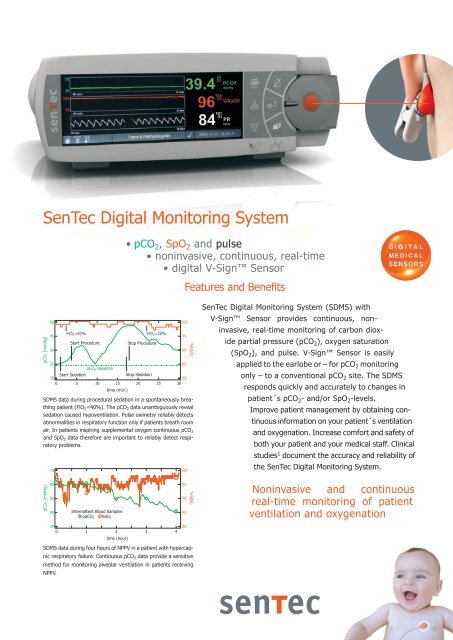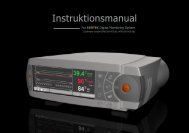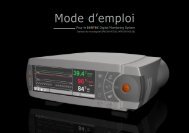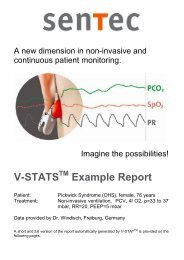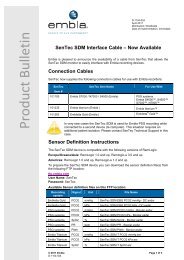SenTec Digital Monitoring System (English) - SenTec AG
SenTec Digital Monitoring System (English) - SenTec AG
SenTec Digital Monitoring System (English) - SenTec AG
You also want an ePaper? Increase the reach of your titles
YUMPU automatically turns print PDFs into web optimized ePapers that Google loves.
<strong>SenTec</strong> <strong>Digital</strong> <strong>Monitoring</strong> <strong>System</strong><br />
pCO 2 (mmHg)<br />
SDMS data during procedural sedation in a spontaneously breathing<br />
patient (FiO 2=40%). The pCO 2 data unambiguously reveal<br />
sedation caused hypoventilation. Pulse oximetry reliably detects<br />
abnormalities in respiratory function only if patients breath room<br />
air. In patients inspiring supplemental oxygen continuous pCO 2<br />
and SpO 2 data therefore are important to reliably detect respiratory<br />
problems.<br />
pCO 2 (mmHg)<br />
50<br />
45<br />
40<br />
35<br />
30<br />
Start Sedation Stop Sedation<br />
80<br />
0 5 10 15 20 25 30<br />
70<br />
60<br />
50<br />
40<br />
FiO 2=40%<br />
Start Procedure<br />
pCO 2 Baseline<br />
time (min.)<br />
Intermittent Blood Samples<br />
paCO2 SaO 2<br />
SDMS data during four hours of NPPV in a patient with hypercapnic<br />
respiratory failure. Continuous pCO2 data provide a sensitive<br />
method for monitoring alveolar ventilation in patients receiving<br />
NPPV.<br />
• pCO 2, SpO 2 and pulse<br />
• noninvasive, continuous, real-time<br />
• digital V-Sign Sensor<br />
Stop Procedure<br />
FiO2=20%<br />
30<br />
0 1 2 3 4<br />
time (hour)<br />
100<br />
95<br />
90<br />
85<br />
100<br />
95<br />
90<br />
85<br />
80<br />
Features and Benefits<br />
%SpO 2<br />
%SpO 2<br />
<strong>SenTec</strong> <strong>Digital</strong> <strong>Monitoring</strong> <strong>System</strong> (SDMS) with<br />
V-Sign Sensor provides continuous, noninvasive,<br />
real-time monitoring of carbon dioxide<br />
partial pressure (pCO2), oxygen saturation<br />
(SpO2), and pulse. V-Sign Sensor is easily<br />
applied to the earlobe or – for pCO2 monitoring<br />
only – to a conventional pCO2 site. The SDMS<br />
responds quickly and accurately to changes in<br />
patient´s pCO2- and/or SpO2-levels. Improve patient management by obtaining continuous<br />
information on your patient´s ventilation<br />
and oxygenation. Increase comfort and safety of<br />
both your patient and your medical staff. Clinical<br />
studies1 document the accuracy and reliability of<br />
the <strong>SenTec</strong> <strong>Digital</strong> <strong>Monitoring</strong> <strong>System</strong>.<br />
Noninvasive and continuous<br />
real-time monitoring of patient<br />
ventilation and oxygenation
V-Sign Sensor<br />
The digital V-Sign Sensor enables simultaneous monitoring of pCO 2, SpO 2 and pulse. It incorporates<br />
the latest opto-electronics and digital signal processing technologies. In combination with local arterialization<br />
of the warmed measurement site, V-Sign Sensor achieves excellent measuring performance.<br />
Applied to the earlobe – a site physiologically close to the central circulation of the cranium – V-Sign<br />
Sensor detects changes in SpO 2 notably earlier than finger pulse oximetry sensors. Applied on sites<br />
other than the earlobe V-Sign Sensor is currently indicated for pCO 2 monitoring only.<br />
Measurement principle<br />
Severinghaus-type pCO 2 measurement<br />
2-wavelength reflectance pulse oximeter<br />
<strong>Digital</strong> microtechnology<br />
Opto-electronic components, micro pH-electrode,<br />
temperature sensors, and a mixed-signal micro-controller<br />
reside on a digital sensor print. Sensor specific<br />
data are stored in a digital memory chip.<br />
Sensor temperature<br />
Set to 42°C (107.6°F) in “Adult” mode<br />
Set to 41°C (105.8°F) in “Neonatal” mode<br />
Preset site time: 8 hours<br />
Supervised by two independent circuits<br />
<strong>SenTec</strong> <strong>Digital</strong> <strong>Monitoring</strong> <strong>System</strong> – overall performance<br />
Carbon Dioxide Partial Pressure (pCO 2) 2<br />
Measurement range: 0 – 200 mmHg (0 – 26.67 kPa)<br />
Resolution: 0.1 mmHg (0.1 kPa)<br />
In Vitro Performance<br />
Drift: typically < 1%/h<br />
Response time (T90): typically < 80 s<br />
<strong>SenTec</strong> <strong>Digital</strong> Monitor (SDM) – technical specifications<br />
Weight<br />
2.5 kg (5. 5 lbs)<br />
Size (HxWxD)<br />
10.2 cm x 27.0 cm x 23.0 cm (4.00” x 10.63” x 9.06”)<br />
Compliance<br />
IEC 60601-1, UL-60601-1, IEC 60601-1-1, IEC 60601-1-2,<br />
IEC 60601-1-4, IEC 60601-2-23, ISO 9919, ISO 10993, ISO 14971<br />
Alarms/Indicators<br />
Audible and visual indicators for high/low pCO 2,<br />
SpO 2, PR alarms and technical alarms. Audible<br />
and/or visual indicators (LEDs) for “Audible alarms<br />
muted permanently/temporarily”, “SDM on/off”, “AC<br />
power/battery”.<br />
Display/Indicators<br />
640 x 240 pixel TFT Color Display. Trend graphs and<br />
numeric values of the measurement parameters.<br />
Plethysmographic waveform or blip bar presentation<br />
of the pulse. Status messages such as “Sensor off Patient”,<br />
“Site time elapsed”, “Battery low” or “Gas bottle<br />
empty” etc. Status icons for “Site Timer”, “Battery”,<br />
“Sensor Temperature”, “Barometric Pressure”, “Gas”.<br />
Interfaces<br />
<strong>Digital</strong> output: RS / EIA 232; supported protocols Sen-<br />
TecLink / Philips VueLink / Spacelabs Flexport / <strong>SenTec</strong><br />
Datalogger / Serial Printer<br />
Analog output: 0–1 V (4 channels, selectable parameter<br />
ranges)<br />
Nurse-call capability<br />
0120<br />
Sensor membrane change<br />
Every 4 weeks under normal use<br />
Characteristics of the sensor head<br />
Diameter: 14 mm (0.55’’)<br />
Height: 9 mm (0.35’’)<br />
Weight: < 3 g (0.1 oz)<br />
Waterproof<br />
Cable<br />
Highly flexible, shielded, polyurethane coated<br />
Transport/Storage (in factory package)<br />
Transport temperature: 0 to 50°C (32 to 122°F)<br />
Long term storage temperature: 15-26°C (59-78°F)<br />
Store sensor with membrane<br />
Oxygen Saturation (SpO 2)<br />
Measurement range: 1 – 100%<br />
Resolution: 1%<br />
Accuracy (Arms) 3 : 70 – 100%: ± 2%<br />
Pulse<br />
Plethysmogram and Pulse Rate (PR)<br />
Measurement range: 30 – 250 beats per minute (bpm)<br />
Resolution: 1 bpm<br />
Accuracy: ± 3 bpm<br />
Patient Data Management<br />
Internal memory: up to 12 days, non-volatile<br />
“V-STATS” (PC-Software) to download, analyze, print data<br />
“<strong>SenTec</strong> Datalogger” (optional) to record data on<br />
MMC-card<br />
Compatible with “Download 2001” (PC-Software)<br />
ENVIRONMENTAL CONDITIONS<br />
Transport/Storage<br />
Temperature: 0–50°C (32–122°F) in shipping<br />
carton<br />
Humidity: 10–95% non-condensing<br />
Ambient pressure: 375–800 mmHg (500–1060 hPa)<br />
Operation<br />
Temperature: 10–40°C (50–104°F)<br />
Humidity: 15–95 % non-condensing<br />
Altitude: -390–3685 m (-1280–12000 ft)<br />
Ambient pressure: 525–800 mmHg (700–1060 hPa)<br />
ELECTRICAL<br />
Instrument<br />
Instrument AC Power: 100–240 V (50/60 Hz)<br />
Electrical Safety (IEC 60601-1): Class I, Type BF<br />
Applied Part – Defibrillation Proof, IPX1<br />
Internal Battery<br />
Type: sealed LiIon battery<br />
Battery capacity: 6 hours (new fully-charged battery)<br />
1 Clinical study data available on request.<br />
2 An algorithm proposed by JW. Severinghaus is used to estimate arterial pCO2 from the measured cutaneous pCO2. 3 SpO2 accuracy specifications are based on controlled hypoxia studies with healthy, adult volunteers (sensor applied to<br />
earlobe) over the specified saturation range.<br />
For Adult, pediatric, and neonatal use<br />
Non-invasive monitoring with just one sensor:<br />
Carbon Dioxide Partial Pressure (pCO2) Oxygen Saturation (SpO2) Pulse - Plethysmogram and Pulse Rate (PR)<br />
Enabled parameters selectable in “Adult” mode<br />
In “Neonatal” mode SpO2/PR are automatically<br />
disabled<br />
Accurate and fast measurement<br />
Convenient and safe sensor application<br />
Lightweight sensor head (< 3 g)<br />
Maximum patient comfort<br />
Application areas/Indications<br />
(Neonatal) Intensive Care, Recovery Room, Respiratory<br />
Medicine, Sleep Labs, Procedural Settings, Intra-Hospital<br />
Transport<br />
(Noninvasive) Ventilation, High Frequency Oscillation<br />
Ventilation, (Post) Extubation, Pain Management<br />
(Conscious sedation, PCA, titration of opioids), Sleep<br />
Diagnostics/Therapy, Titration of oxygen (COPD)<br />
TFT Color Display<br />
Selectable Parameter Color<br />
Various preconfigured Measurement Screens<br />
Ready for use<br />
Integrated docking station stores and automatically calibrates<br />
the V-Sign Sensor<br />
Cost-effective<br />
Reduces the number of blood samples required to assess<br />
patients’ ventilation and oxygenation<br />
Your local distributor:<br />
RF-005856-e<br />
<strong>SenTec</strong> <strong>AG</strong> Phone +41 61 726 97 60<br />
Ringstrasse 39 Fax +41 61 726 97 61<br />
CH-4106 Therwil info@sentec.ch<br />
Switzerland www.sentec.ch<br />
Specifications are subject to change without notice


